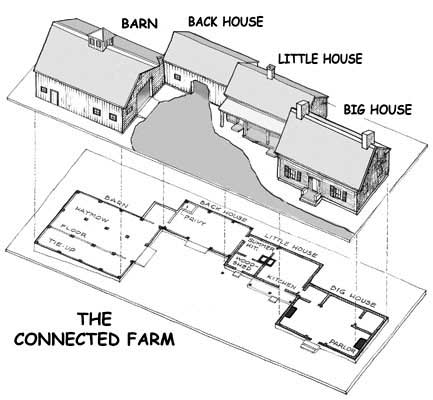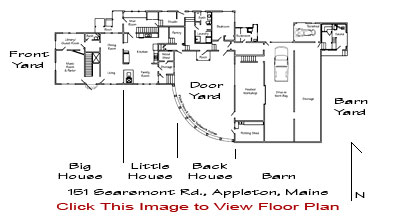 This rare Appleton property is a classic 19th Century Greek Revival Cape-style farmstead, consisting of a Big House, Little House, Back House, and Barn, all connected.
This rare Appleton property is a classic 19th Century Greek Revival Cape-style farmstead, consisting of a Big House, Little House, Back House, and Barn, all connected.
History
Although this four-part arrangement might sometimes appear haphazard, most nineteenth-century New England connected farm buildings shared similar patterns of spatial organization and usage. Most farms were aligned at right angles to the road with the major facades of the big house and the barn facing the road. Farmers then oriented their line of connected buildings to shelter a south- or east-facing work yard, called the door yard, from north or west winter winds.
Thus the formal front yard was an extension of the architecturally formal big house, the working door yard was an extension of the workrooms in the little house and the back house, and the animal barnyard was an extension of the barn. The front door faced towards the milder and sunnier south, regardless of where the road lay.
A barnyard was usually located on the south or east side of the barn for similar reasons. Many farmers also added a formal front yard between the front door of the big house and the road. This three-yard system was the dominant pattern for connected farms during much of the nineteenth century and reinforced the functional organization of the farm.
As late as the 1800s, connected architecture remained rare outside Maine and New Hampshire, although writers continued to praise the design, as in this 1893 description of a New England barn in The Cultivator and Country Gentleman:
"A shed in which there is a watering trough ... connects with the south and left-hand end of the barn ... This shed connects with the house, so that the entire work of a day can be done without once setting foot out-of doors - a convenience that means a great deal in stormy days, and periods of extreme cold...."
For almost one hundred years the connected farm building plan flourished in New England, and in many areas it was the most popular form of rural and small-town domestic architecture before 1900. Throughout most of rural Maine and New Hampshire, about 50 percent of the dwellings follow this pattern, with lesser densities in areas further from Maine. In many Maine towns, over 70 percent of the PRE-1900 dwellings followed the connected building arrangement.
Big House
 The Big House, the major farmhouse: it is given the finest ornamentation. It usually faces the road and is the nearest structure to it. The big house is usually identified as the farmhouse by the farm family and contains the formal parlor room and the bedrooms or "chambers" on the second floor. In spite of its size and architectural refinements, it was seldom used for daytime activities in the nineteenth century and was primarily a place of rest.
The Big House, the major farmhouse: it is given the finest ornamentation. It usually faces the road and is the nearest structure to it. The big house is usually identified as the farmhouse by the farm family and contains the formal parlor room and the bedrooms or "chambers" on the second floor. In spite of its size and architectural refinements, it was seldom used for daytime activities in the nineteenth century and was primarily a place of rest.
Little House
The Little House was, and still is, the kitchen building and active living center for the farm family. A workroom or "summer kitchen" usually adjoined the kitchen and was connected to the "wood house," used for firewood storage. The kitchen and its support rooms constituted the major work areas for the women of the farm.
Back House
The Back House extends from the kitchen or little house to the major barn. It usually contained a wagon bay and multi- purpose work and storage spaces for house and barn. The farm outhouse or privy was usually located in the corner of this building closest to the barn and is also referred to as the back house. A three-hole privy with plastered and wall-papered walls was removed from the northeast corner of the Appleton backhouse in 1999. Together, the little house and the back house buildings are commonly called the ell, which was a term derived from the typical L-shaped plan relationship between the big house and its kitchen addition.
Barn
 The Barn terminates the connected building complex and, as on most American farms, is the functional center of the farming operation. On the New England farm, it primarily sheltered farm animals and their food. The structural framing for all nineteenth- and twentieth-century New England barns was a heavy timber, mortise-and-tenon system. The major structural unit in the simplified framing system of the New England barn was the bent (click on the inset image to see a bent from the Appleton barn; note the wooden pegs or trunnels fastening the mortise-worked joints), which is the key component in the raising sequence. The major-rafter, minor-purlin roof framing system of the old English barn of eastern New England (used in this Appleton property), where roof sheathing boards run vertically across purlins, was relinquished only after about 1840 for the major-purlin and common-rafter system. This more modern system was employed, likely in the late 1800's, to raise the ceiling in the Appleton barn's east-side milking bays.
The Barn terminates the connected building complex and, as on most American farms, is the functional center of the farming operation. On the New England farm, it primarily sheltered farm animals and their food. The structural framing for all nineteenth- and twentieth-century New England barns was a heavy timber, mortise-and-tenon system. The major structural unit in the simplified framing system of the New England barn was the bent (click on the inset image to see a bent from the Appleton barn; note the wooden pegs or trunnels fastening the mortise-worked joints), which is the key component in the raising sequence. The major-rafter, minor-purlin roof framing system of the old English barn of eastern New England (used in this Appleton property), where roof sheathing boards run vertically across purlins, was relinquished only after about 1840 for the major-purlin and common-rafter system. This more modern system was employed, likely in the late 1800's, to raise the ceiling in the Appleton barn's east-side milking bays.

 This rare Appleton property is a classic 19th Century Greek Revival Cape-style farmstead, consisting of a Big House, Little House, Back House, and Barn, all connected.
This rare Appleton property is a classic 19th Century Greek Revival Cape-style farmstead, consisting of a Big House, Little House, Back House, and Barn, all connected.

